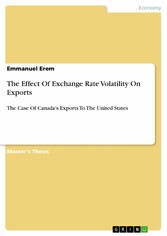Suchen und Finden
Service

The Effect Of Exchange Rate Volatility On Exports - The Case Of Canada's Exports To The United States
Emmanuel Erem
Verlag GRIN Verlag , 2019
ISBN 9783668903920 , 61 Seiten
Format PDF
Kopierschutz frei
Geräte
Mehr zum Inhalt

The Effect Of Exchange Rate Volatility On Exports - The Case Of Canada's Exports To The United States
Master's Thesis from the year 2018 in the subject Economics - International Economic Relations, grade: A, National University of Ireland, Maynooth (Department of Economics, Finance and Accounting), course: MSc Economic and Financial Risk Analysis, language: English, abstract: The purpose of this thesis is to examine the effect of real exchange rate volatility between the Canadian and US dollars on real exports from Canada to US. The study uses quarterly data from 1960-2017. The GARCH (1, 1) is used to model exchange rate volatility. After finding the variables are non-stationary with no co-integration, a VAR (Vector Auto regression) model is used to investigate the short-run relationship in the variables using Granger causality, impulse response functions and variance decomposition estimates. The results reveal that the effect of exchange rate volatility is of mixed signs with coefficients that are not statistically significant. The thesis is divided into 7 chapters; chapter 2 gives an overview of important literature and contributions by researchers over the years specifically covering the relationship between exchange rate volatility and trade, exchange rate regimes, exchange rate target zones and inflation targeting. Chapter 3 presents the model and data used, definitions of the variables and the predictions of the model. Chapter 4 gives a theoretical and econometric overview of the unit root and co-integration tests. Chapter 5 gives the data output of the empirical results and discussions of test results. This output is presented using graphs and tables. Chapter 6 is a presentation of the limitations of the model and possible areas of improvement. Lastly, chapter 7 concludes and gives policy recommendations moving forward. Exchange rates are a key player in any economy that is engaging in international trade. A stable monetary policy system and financial sector play a key role in ensuring the exchange rate stability of the currency of a country. Firms and traders rely on prevailing exchange rates to forecast amounts to produce, import and export; thus are very much affected by the exchange rate volatility. In addition to this, there is a currency conversion cost in international trade. Traders use a number of products in financial markets to hedge against currency fluctuations; these include among others forwards contracts. This is especially true for short-term hedging than long-term hedging.
Shop

